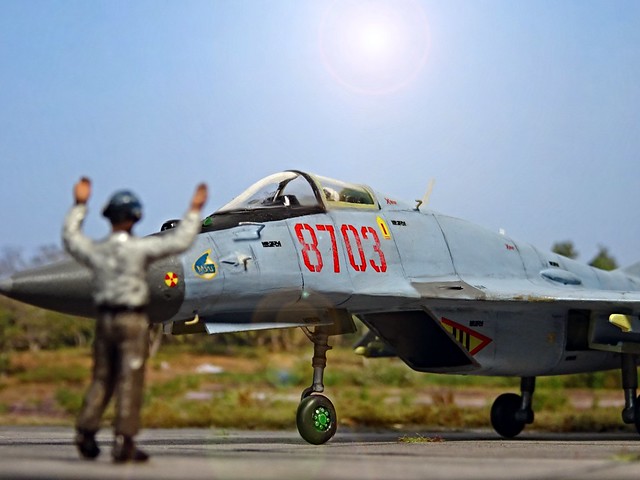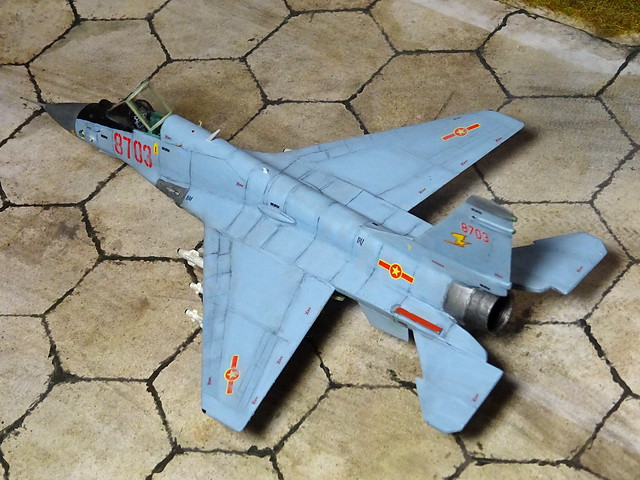Einmal mehr eine Laubsägearbeit...


 Some background:In the late 1970ies, the Mikoyan OKB design bureau began working on a very light “strike fighter” that was intended to be a direct competitor to the F-16 Fighting Falcon. This new Mikoyan design, designated Izdeliye 33 (Izd 33) (and variously translated as “Article 33”, “Project 33”, “Product 33”, or “Project R-33”), was of conventional layout and similar in appearance to the F-16, with a fixed geometry, chin-mounted air intake and a blended wing and body layout and pronounced leading edge root extensions (LERX).
Some background:In the late 1970ies, the Mikoyan OKB design bureau began working on a very light “strike fighter” that was intended to be a direct competitor to the F-16 Fighting Falcon. This new Mikoyan design, designated Izdeliye 33 (Izd 33) (and variously translated as “Article 33”, “Project 33”, “Product 33”, or “Project R-33”), was of conventional layout and similar in appearance to the F-16, with a fixed geometry, chin-mounted air intake and a blended wing and body layout and pronounced leading edge root extensions (LERX).
The aircraft was originally powered by a single Klimov RD-33 afterburning turbofan engine – the same engine used by the twin-engined MiG-29. Overall, the Izdeliye 33 was less complex and capable than the MiG-29, but also much cheaper in acquisition and operation.



The Izdeliye 33’s outlines resembled the MiG-29, but actually only a few components were shared, e .g. the landing gear. All aerodynamic surfaces were different, and the BWB fuselage with its single engine and air intake duct necessitated a much different internal structure.
After extensive wind-tunnel testing and evaluation of several aerodynamic details (e. g. different LERX layouts with blended edges or dogtooth tips, and different elevator layouts), the first prototype was built and successfully tested in 1984.
Progress was slow, since most of OKB MiG’s resources were concentrated on the MiG-29, though, but the aircraft showed good characteristics. State acceptance trials were underway when the program received a hard blow in 1986: the Soviet Air Force (VVS) dropped its support for the Izdeliye 33, due to VVS’ change of operational needs, financial constraints, a growing preference for multirole designs and the doctrine not to operate single engine combat aircraft anymore.



Since development of the Izdeliye 33 had already progressed to the hardware stage and the VVS was about to introduce it’s a new fighter generation (the MiG-29 as tactical fighter and the bigger Su-27 as long range inteceptor), which were not allowed for export at that time, the Izdeliye 33’s role was changed.
With the domestic market barred, it became a light fighter aircraft with not-so-up-tp-date avionics for foreign operators, much like the former American F-5 program. Sales potential was regarded as high, because many Soviet-friendly nations operating the ageing MiG-21 or MiG-23 export models at that time would appreciate a relatively simple and cost-efficient replacement.



In due course the aircraft received the official designation MiG-33SE ("S" for, "seriynyy" = serial and "E" for "eksportnyy" = export).
These production aircraft differed in several details from the Izdeliye 33, the most obvious change were enlarged elevator surfaces and bulges on the flanks which had become necessary in roder to fit bigger low pressure tires to the main landing gear for operations on rough airstrips.
Compared with the prototypes, the operational MiG-33 was powered by a Tumansky R-25-300 turbojet, rated at 55 kN (12,000 lbf) dry military power, 68.5 kN (15,400 lbf) with afterburner and 96.8 kN (21,800 lbf) for 3 minutes with boosted afterburner (CSR mode, altitude < 4,000 metres (13,000 ft)). The air intake received an adjustable ramp and the radome became smaller.


The first airframes left the Sokol production plant at Nizhny Novgorod in 1987. When the aircraft became known to the public it received the ACSS code name “Foghorn” in the West.
Instead of the MiG-29's state-of-the-art Phazotron RLPK-29 radar fire control system, a less sophisticated RLPK-29E targeting system, based on the N019EA "Rubin" radar, was fitted. As a secondary sensor, a modified S-31E optoelectronic targeting/navigation system and different IFF transponders were fitted.
This avionics suite still featured modes for look-down/shoot-down and close-in fighting. With this equipment, the MiG-33SE was able to carry the new and very effective R-73 (NATO: AA-11 "Archer") short-range air-to-air missile, as well as the R-27 (AA-10 "Alamo") mid-range AAM with IR and radar homing. A SPO-15L "Beryoza" ("Birch") radar warning receiver was carried, too, along with chaff/flare dispensers.
The new type quickly found buyers: first orders came, among others, from Algeria, Angola, Eritrea, North Korea and Vietnam, and deliveries started in early 1988. In 1989 the MiG-33SE was also offered to India for license production (replacing the country’s large MiG-21 fleet), but the country wanted a more potent aircraft and eventually became one of the first MiG-29 export customers.


Beyond its operational service, the MiG-33SE left other footprints in Asia, too. Following the cancellation of U.S. and European companies’ participation in the development of the Westernized Chengdu J-7 variant known as the “Super-7”, China launched a program in 1991 to develop an indigenous evolution of this MiG-21-based design, which it designated the FC-1 (“Fighter China 1”).
To expedite its development, officials of the Chengdu Aircraft Industries Corporation (CAC) or the China National Aero-Technology Import and Export Corporation (CATIC) – perhaps both – approached Mikoyan for technical support.
In 1998, CATIC purchased Izdeliye 33 design and test information from the Mikoyan design bureau, along with other research and development assistance. These designs were used for the development of JF-17 / FC-1 by Pakistan and China, which entered production in 2007.
General characteristics: Crew: 1
Length (incl. pitot): 16,2 m (53 ft)
Wingspan: 10.73 m (35 ft 1.5 in)
Height: 5,5 m (18 ft)
Wing area: 35,6 m² (382 ft²)
Empty weight: 18,900 lb (8,570 kg)
Loaded weight: 26,500 lb (12,000 kg)
Max. takeoff weight: 42,300 lb (19,200 kg)
Fuel capacity: 3,500 kg. (7,716 lbs.) internally
Powerplant: 1× Tumansky R-25-300 turbojet, rated at 55 kN (12,000 lbf) dry military power,
68.5 kN (15,400 lbf) with afterburner and 96.8 kN (21,800 lbf) emergency power
Performance: Maximum speed: Mach 2.2 (2,530+ km/h, 1,500+ mph) at high altitude
1,110 km/h (690 mph) at low altitude
Range: 1,550 km (837 nmi, 963 mi) with drop tanks
Ferry range: 3,335 km (1,800 nmi, 2,073 mi) with auxiliary fuel
Service ceiling: 17,060 m (59,000 ft)
Rate of climb: 285 m/s (56,000 ft/min)
Wing loading: 337 kg/m² (69 lb/ft²)
Thrust/weight: 0.7 at loaded weight
Maximum design g-load: +9 g
Armament: 1x 30 mm GSh-30-1 cannon with 150 rounds in the left fuselage side
7 Hard points (6x pylons under-wing, 1x under fuselage) for up to 3,500 kg (7,720 lb)
of ordnance including six air-to-air missiles — a mix of semi-active radar homing
(SARH)/infrared homing R-60, R-27, R-73, active radar homing R-77 AAMs.
Air-to-ground weapons include RBK-500, PB-250, FAB-250, FAB 500-M62, TN-100, ECM Pods,
S-8 rockets in respective pods, S-24 unguided rockets and guided Kh-25 and Kh-29 ASMs




